At some point in most runners’ lives, even if they don’t live up North, they’ll be faced with running in the snow. And, wonder, how do I run in the snow? Can you run in the snow?
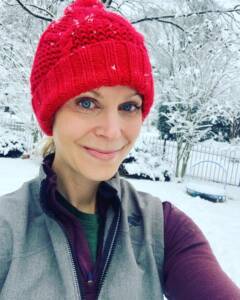
With some proper gear and an altered mindset, running in snow can be a cathartic, serene, even magical experience—especially if you’re running in fresh snow. The world is quiet. Pristine. Untouched. And, simply beautiful.
You will return home a much more patient and happier person (and mom).
However, running in snow (and running on ice!) can be dangerous and treacherous. You’ve probably seen this news clip where runners are touting how they weren’t going to skip their run because of wintry weather, only to fall on their butts. It’s a good watch if you haven’t seen it.
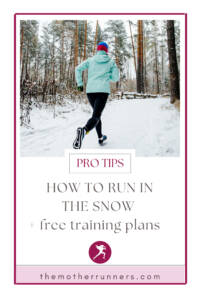
All jokes aside, you can get seriously hurt running in snow—and I want to help you avoid that.
So, in this article, I’m going to cover all things running in snow-related including:
- Is it okay to run in the snow?
- How to run in the snow
- Is it harder to run in the snow?
- Do you burn more calories running in the cold and snow?
- Can you run on ice?
- What to wear running in the snow
- And 7 tips for running in the snow
So, let’s go!
Is it okay to run in the snow?
Yes, it is okay to run in the snow—as long as you are prepared. In fact, running in the snow provides many mental benefits as well as physical. Running in snow strengthens mental toughness and a runner’s ability to deal with adversity—which is key for race day. It can also provide mental clarity, calm, peace, and reduced stress and anxiety.
Running in the snow also provides physical benefits of being active in nature and works many stabilizer muscle groups not typically used when running.
How do you run in the snow?
If you are running in snow, the biggest thing to do is throw out any pace goals you have and just enjoy the scenery and experience.
Here are three quick tips for running in snow:
Run slow.
You will run slower in the snow (and you should run slower. Just own it.) Recognize that running in the snow is a good workout even if you aren’t going as fast as you usually do. You’re working muscles you typically don’t use while running.
Shorten your stride.
You will need to shorten your stride. That is the key to running in the snow without slipping. When you pick up your feet, you can slide when you land. Do the snow shuffle and enjoy the easy run day.
Look for fresh snow.
Also, look for fresh snow that hasn’t been iced over, plowed paths, or running trails that have better traction. Fresh snow has the added benefit of an extra cushion if you do fall.
Related: Benefits of an Easy Running Pace
Is it harder to run in the snow?
Yes, it is harder to run in the snow because you are working different stabilizer muscle groups usually not activated when you run on dry surfaces.
These muscles are trying to help you keep your balance and there is a good chance you will be sore the day after running in the snow, even if your pace was super slow! Your calf and foot muscles also work extra hard running in the snow to keep you upright and moving forward.
Thus, running in the snow is a better workout than running slow on dry ground. It’s like running on sand or trails.
Do you burn more calories running in the cold and snow?
Yes, according to research, you do burn more calories running in the cold and running in the snow.
First, if you’re shivering, that movement burns calories.
Second, your body taps into brown fat to warm your body which requires more energy expenditure, and burns calories. This is a process called non-shivering thermogenesis.
Third, running in the snow works muscles you aren’t used to working, which can also burn more calories.
So, you may not be running as fast or as far, but you are still getting a great workout running in the snow.
Related: How to Stay Motivated Running in the Winter
Can you run on ice?
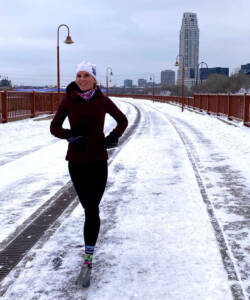
You can run on ice IF you have the right shoes. If you don’t have the right shoes, do not attempt to run on ice or else you risk falling and injuring yourself!
You want shoes that have spikes on the soles to run in ice. This provides traction and prevents slipping. (More on what brands below!)
If you do not have proper shoes for running on ice, consider running on a treadmill, finding a parking garage (spontaneous hill workout day!), or doing bodyweight exercise instead (download my free strength plan).
Related: Smart Treadmill Running Tips for Mother Runners
What should I wear for running in snow?
The most important item you need for running in the snow is running shoes with traction!
Good running shoes for running in snow include:
- Atlas snowshoe which are pricey at $250 but allow you run your normal speed, or even faster paces, in snow.
- A good pair of waterproof trail shoes like the Saucony Peregrine 11 which provides tacky traction underfoot.
- Yaktrax Pro which slips over your shoes like chains on a car tire
- Khatoola Nano Spikes can also be put over a waterproof shoe
Some brands of spikes for running on ice include:
- IceBugs (most popular) that have spikes already on the bottom of the shoe
- Yaktrax Pro which are good for both snow and ice
- Khatoola Nano Spikes which are also good for both snow and ice
- Or, you can do it yourself by screwing 1/2-inch sheet metal screws but doing this you risk putting them in the wrong place. (Watch mother runner, running coach and 2:58 marathoner Michelle Baxter, who lives in Anchorage, Alaska, demo putting screws into her running shoes.)
Note: wearing any of these brands that have spikes on pavement, concrete, or cleared roads will quickly wear them down.
To protect your eyes for running in the snow during daylight, consider sunglasses such as Roka running sunglasses or the more affordable Knockaround and Goodr.
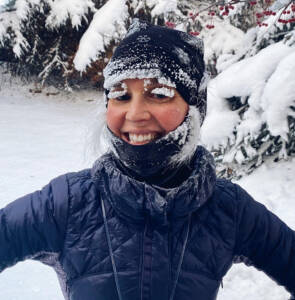
To keep your feet dry, wear waterproof shoes, duct tape your shoes, wear moisture-wicking socks, and/or put plastic around your ankles. Take the insoles out and stuff them with newspaper when you get home to expedite drying.
To protect your bum from any falls, wear an extra layer of sweats, fleece-lined pants, or padded cycling shorts.
Also, wear a headlamp and reflective gear.
Get my full winter dressing guide here.
7 Tips for Running in Snow
Don’t run fast.
This is not the time to do speedwork or striders. Instead, focus on shortening your stride and slowing your speed. Make it an easy running, base-building day.
Also, run for time instead of distance since it will take you much longer. If that messes with you mentally because you are big on mileage, remember that running in snow works for different muscle groups and is a great workout!
Be cautious.
Watch your footing when you run and don’t be overly zealous. You never know where black ice can be hiding—even under fresh snow. So, tread lightly with your feet as low to the ground as possible.
Also, avoid areas with lots of cars. Leave your earbuds at home and listen to the softly falling snow instead. And dress in bright clothes so you can be seen!
Shift the time you run time.
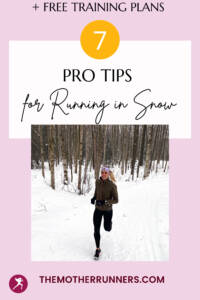
If you can do a “runch” (aka run at lunch) make it happen since ice tends to form at dawn and dusk. If those are your typical run times, you’re more at risk of slipping in the snow. Try to work your schedule so you can run during the day.
Seek the paths most shoveled.
If you aren’t used to running in your snowy area, ask around (including at a running store) where roads are the clearest, less trafficked by cars, and/or lit by streetlamps. Or, opt for snowy trails which will provide better traction.
Wear the right clothes for the snow.
Wear waterproof shoes with treads (use something like Yaxtrax to add traction if trail shoes won’t work). Also wear sunglasses if you are running during the day, reflective or illuminated gear if running in the dark, padded bottoms, moisture-wicking socks, and extra layers.
Start against the wind.
You’ll likely be getting cold towards the end of your run, so start out against the wind so the trek home is more pleasant.
Opt for the treadmill.
Know when it’s just too slippery to run outside in the snow and opt for a treadmill run instead. A treadmill is especially a great option if you have a speed workout that you must absolutely do that day. Running in a parking garage is also an option if you need to do running intervals or hill repeats.
I would love to help you with your winter running and beyond. Check out my run coaching services.
